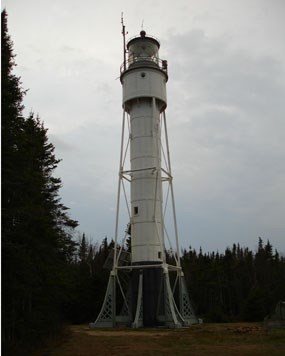
The final jewel was placed in the necklace of lights around the Apostle Islands when the beacon on Devils Islands was lit in 1891. A two-story, red brick, Queen Anne- style keeper's dwelling and a building for the steam fog signal were completed at this time, but the light was placed in a temporary tower. The tower, made of wooden timbers, held a fourth order, nonflashing red light. A two-story, brick and shingle house similar in design to the keeper's dwelling was built for the assistant keepers in 1897. Work began on the permanent tower, an 82- foot tall steel cylinder, that same year. Although the tower was ready in the fall of 1898, there was a three year delay in supplying it with a lens. A third order lens from the Paris firm of H. Lepaute finally arrived in April 1901. The permanent tower was placed in service shortly afterward, and the temporary tower torn down the same year. The lighthouse was originally designed as a plain, self-supporting cylinder, but the high winds of its exposed location caused the tower to shake so badly that lightkeepers complained that the motion sometimes extinguished the lamp. In 1914, the Lighthouse Service reinforced the structure with external braces, alleviating the problem and giving the tower the appearance we see today. Devils Island's flashing red light became a major landmark along trans-Superior shipping lanes. The station's steam fog signal was replaced in 1925 with a compressed air diaphone and a radio fog beacon. Ships on the lake could use the time delay between the radio and audible signals to determine their distance to the station. Devils Island eventually became the last manned station in the Apostle Islands. As the other lights were automated, the Coast Guard maintained a five-man crew on Devils Island to watch over the beacon and perform periodic maintenance on the other island lights. This era finally ended in 1978, when the Devils Island light was automated as well. When the Coast Guard detachment hauled down their flag, it marked the end of over a century of lightkeepers tending lights in the Apostle Islands. The lighthouse at Devils Island is the only one among the Apostles group to retain its original Fresnel lens, though there was a three-year period when the lantern room was empty. The U. S. Coast Guard removed the third order Fresnel lens from the tower in 1989 and replaced it with a smaller, plastic beacon. The National Park Service repaired the lens and returned it to the tower as a display in 1992. While technological advances decreased the importance of lights as navigational tools, these lighthouses have acquired a significance beyond their importance to mariners. They represent a fascinating period in the historic development of the region. They also remind us of the brave men and women who tended these remote outposts to make life safer for sailors navigating the waters of the Apostle Islands. Visiting the Lighthouse |
Last updated: April 10, 2015
